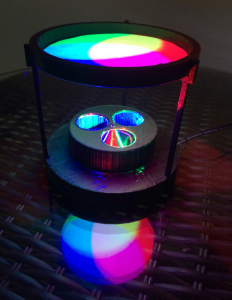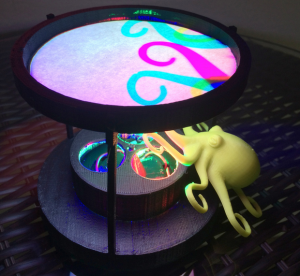 Not every project is going to work exactly as expected–in fact, most projects, devices or experiments will most likely end in failure. But dealing with a failure is an incredibly important skill that is often just as important as our successes. Personally I rarely consider anything a failure unless I don’t learn a lesson from it because in reality, a failure is just part of the process of creation. For just about any task we perform, learning how to do something is often just as important as learning why not to do that something a specific way. Sometimes we learn what not to do by seeing how other people do it and sometimes we learn what not to do by having things blow up in our faces, but both produce similar results as we find better ways to do what we were trying to do.
Not every project is going to work exactly as expected–in fact, most projects, devices or experiments will most likely end in failure. But dealing with a failure is an incredibly important skill that is often just as important as our successes. Personally I rarely consider anything a failure unless I don’t learn a lesson from it because in reality, a failure is just part of the process of creation. For just about any task we perform, learning how to do something is often just as important as learning why not to do that something a specific way. Sometimes we learn what not to do by seeing how other people do it and sometimes we learn what not to do by having things blow up in our faces, but both produce similar results as we find better ways to do what we were trying to do.
It is also important to remember that not every project that turns out differently than intended should be considered a failure. Sometimes we do things that didn’t turn out the way that we wanted, but we still end up with something that is useful or pretty cool. The microwave oven, Teflon coating, Velcro and even Play-Doh and Silly Putty are all the byproducts of experiments that were performed with different goals in mind. Now I’m not suggesting that Thingiverse user Marcio Teixeira’s Rainbow Apparatus is the next microwave oven, because obviously not. But the fact that he intended to create a different device than he ended up with doesn’t make the final result any less of a success.
“The Rainbow Apparatus is the latest and most ambitious in a series of designs based on a ray casting principle. The idea is that you start with the illumination pattern you desire and then construct a 3D printed object with holes that project that precise pattern. My use of this technique was inspired by the stereographic projection work of Henry Segerman and Saul Schleimer. In its current form, The Rainbow Apparatus is much simpler than it was originally conceived. At the start, it was an attempt to paint a recognizable color picture using light. When this didn’t pan out, it was rebranded as an interactive light piece,” Teixeira explained.
The device, as originally intended, would have cast light using the three primary colors of red, green and blue. By projecting the light in specific arrangements and patterns through a 3D printed filter, Teixeira believed that he could paint full color pictures with light. Similar to the effects of the popular t-shirt printing process offset lithography, the device would create complex, multi-colored images–only they would be made of projected light, not pigmented paints or dyes. Teixeira intended his “filters” to be 3D printed discs that could be placed inside of the Rainbow Apparatus and project the colored designs on the screen.
While the concept is sound, unfortunately Teixeira’s 3D printer was not up to the task and the final printed discs simply projected a blurry mass of light. Teixeira had to admit to himself that a standard FDM 3D printer would just not be able to produce the print accuracy that such a device would require. But thankfully, Teixeira saw the value in the device that he did create, and even without the light-painting discs the Rainbow Apparatus still had value. Not just as a cool lamp, but the apparatus refracts and alters the shadows of objects placed in front of the light projectors. This makes it ideally suited for demonstrating the concept of additive colors in a physics classroom setting.
Take a look at some video of the Rainbow Apparatus in action:
Teixeira designed all of the 3D printed parts for the apparatus using OpenSCAD, and he has happily shared the source code on Thingiverse. He combined the printed components with three high-powered red, green and blue LED lights and a basic power supply. He suggests either an adjustable benchtop power supply or a power adapter connected to an adjustable DC-to-DC buck converter, both options being fairly easy for most makers to source.
Have you had any projects turn out differently than intended? Let us know about them over on our 3D Printed Rainbow Apparatus forum thread at 3DPB.com.
Subscribe to Our Email Newsletter
Stay up-to-date on all the latest news from the 3D printing industry and receive information and offers from third party vendors.
You May Also Like
3D Printing News Briefs, April 20, 2024: Manufacturing 4.0 Consortium, Blow Molding, & More
We’re starting with news about a manufacturing consortium in today’s 3D Printing News Briefs, as OPEN MIND Technologies has joined the Georgia Tech Manufacturing 4.0 Consortium. Moving on, industrial machining...
Meltio and Accufacture Unveil Robotic Metal 3D Printer Made in the US
Meltio has partnered with Michigan-based robotics firm Accufacture to introduce Alchemist 1, a robotic cell designed for wire-laser metal 3D printing made in the US. This new system represents a...
3D Printing News Briefs, April 13, 2024: Robotics, Orthotics, & Hypersonics
In 3D Printing News Briefs today, we’re focusing first on robotics, as Carnegie Mellon University’s new Robotics Innovation Center will house several community outreach programs, and Ugogo3D is now working...
Rail Giant Alstom Saves $15M with 3D Printing Automation Software 3D Spark
3D Spark has entered into a three-year deal with the rail giant Alstom. Alstom, a transport behemoth with annual revenues of $16 billion, specializes in the manufacture of trains, trams,...































